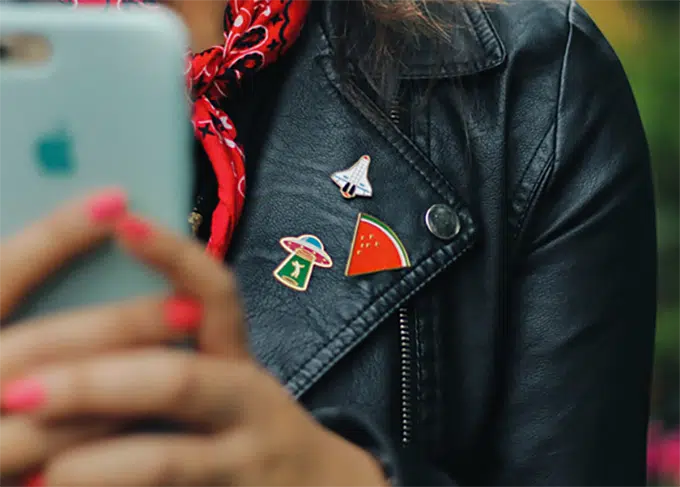words Al Woods
In saltwater angling, surf fishing is one of the most entertaining and user-friendly pursuits. Here’s all the information you need for surf fishing for beginners!
If you are close to the coast, saltwater angling is perhaps your introduction to the world of fishing. The endless shorelines give many exciting opportunities for beginners looking to dive into fishing.
Are you new to surf fishing? We’ll let you in on all the scoops about surf fishing for beginners, including how to choose your fishing gear, baits, lures to identify the ideal spot on the beach!
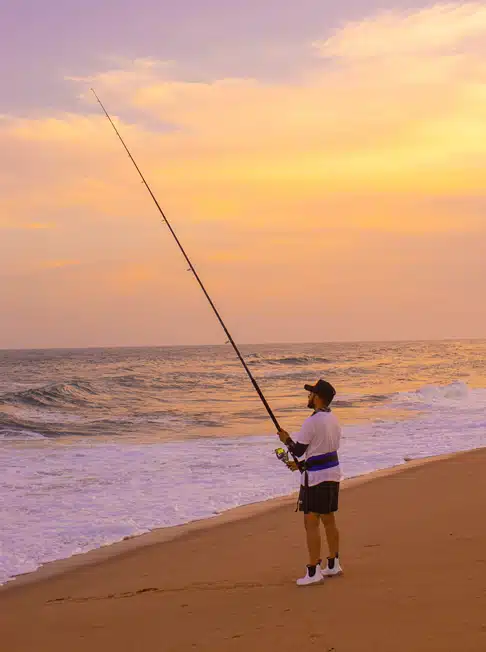
Surf Fishing Rods & Surf Fishing Reels
Surf fishing reel
Spinning reels are the most popular for surf fishing. We recommend choosing a spinning reel anywhere between 6000-8000 in size range and has a line capacity of 500yds of 25lb braid.
You are likely to encounter many large species, such as rays or sharks, that can grow over 3ft long and can drag your line to as far as hundreds of yards. That’s why you need a spinning reel of significant line capacity.
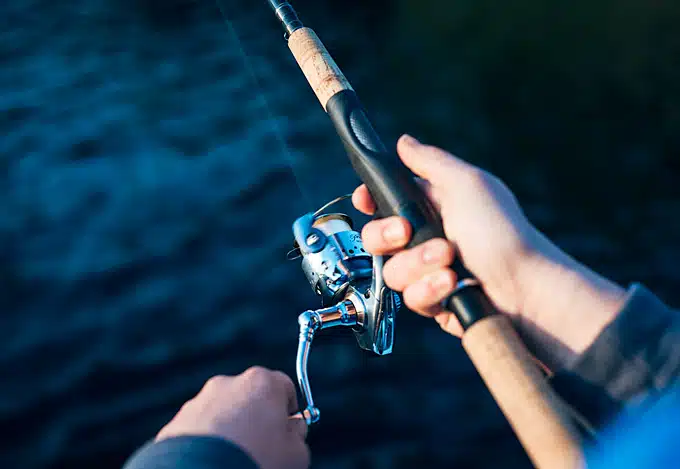
6000-8000 Is Good Range Size For Spinning Reels In Surf Fishing
If you’ll be hitting the sea specifically, check out the top saltwater spinning reels here.
Surf fishing rod
The same goes with fishing rods. Surf fishing calls for much larger fishing rods than freshwater fishing for further bait casting and handling bigger and stronger fish. You will need to use a surf rod at least 8ft for areas with calm water. Yet, we recommend shooting for a minimum rod length of 10ft to accommodate more fishing spots.
Also, be mindful of the power and action ratings of the rod. Most surf fishers settle for medium-heavy power ratings and moderate action for their rods. With such strength and bendability, these rods can tackle heavy fish over 3ft long.
Surf fishing line
Surf anglers typically use braid as their fishing line of choice. Braid is superior to cast in choppy weather and tough surf conditions since its small diameter provides better resistance to the stiff wind and currents.
The amount of braid line entirely depends on the spool capacity. Hence, for a spinning reel that can hold 500 yds of 25lb braided line, load it up with that amount of line.
Best Surf Fishing Rigs For Frozen Baits
Frozen baits, such as shrimp, squid, shad, mullet, and bunker, are among the best choices for surf fishing. When using frozen bait, it is recommended to use fresh seawater to freeze it in. This helps it retain firmness and flavor for the target fish.
Different types of frozen baits require different rigging techniques to present them in the most attractive way for the fish.
Surf Fishing With Lures
The two key elements affecting the choice of lures for surf fishing are wind and waves. That’s why heavy, lower-profile lures gain the upper hand in most cases. A heavy lure cast through a strong gust will enable you to get your offering to your target fish.
Jigs, spoons, and topwater poppers are some of the favorites of beach anglers. Lures are best used when the water is clear, and the surf is moderate, which are optimal conditions for fish to spot them better.
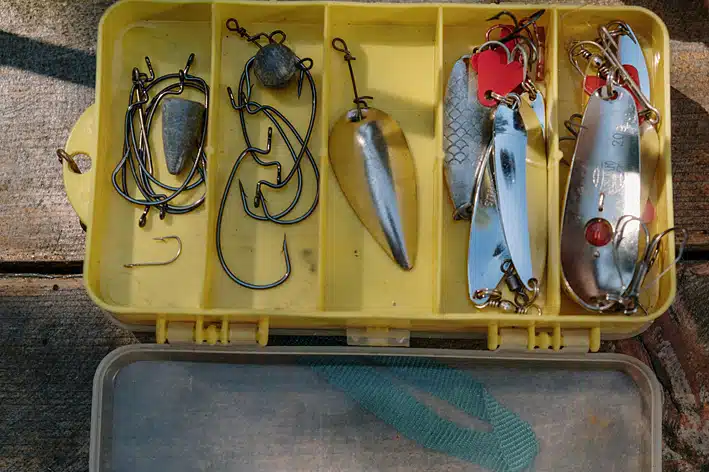
Surf Fishing Gear
Collecting enough fishing gear to the beach is also an important point in surf fishing for beginners to keep you always in the best position for fishing. Here’s what you’ll need to prepare in your tackle box:
- Knife: Keep a 6-to-9-inch knife at hand for when you want to cut frozen baits and filet the fish for eating.
- A pair of pliers: Pliers are your best bet to take off fishhook
- A pair of bolt cutters: You may need them when the hook is swallowed, or you want to trim a piece of wire off.
- Sand spikes: When fishing with several rods, this tool is essential to secure your rods in place.
- Towel: You can use it to keep everything clean and organized.
The Best Time To Surf Fish
While fish can bite anytime throughout the day, the prime time for surf fishing is 2 hours around the high tide. During these hours, the water is deep, and the tide is moving, a combination of many bites. Saltwater fish don’t like still water, so they rarely feed unless the water is moving.
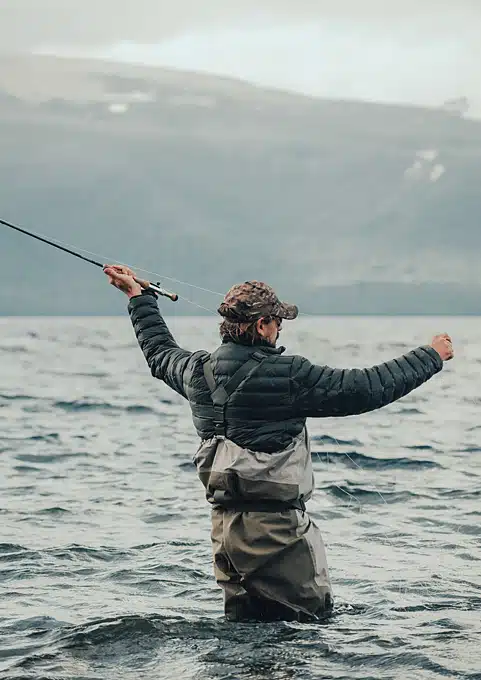
2 Hours Around The High Tide Is The Ideal Time To Fish
The 2 hours around low tides can also be promising due to the moving currents. The only issue is that the water can be too shallow to hold fish, lowering the possibility of getting bites.
Surf Fishing Setup And Strategy
One of the tried-and-true rules that hold up well to most savvy anglers is to fish with two rods at once. Having different gears lets you target multiple species and increase the winning chance.
It is ideal to have one pole rigged with cut baits for big games such as stripers and blues. The cut baits can be soaked on the bottom while the rod is held in a rod holder.
Another rod should be a regular-sized spinning rod with a smaller rig for squid or shrimp to target smaller species suc
h as mullets, croaker, spot, flounder, etc.
Standing between the two rods means that you can manage the bites better by reacting quickly, thus boosting your catch rate. Thinking about more rods to get more bites?
With 4 or 5 rods, you’re sure to enjoy more bites, yet this might happen when you are busy baiting hooks, configuring rigs, or fighting a hooked fish. Unfortunately, that means you cannot land them all, and your offerings are only there for the fish to steal.
Your baits need to stay at the bottom, awaiting the fish. However, the waves and currents can bring them back to shore, so you may want to add more weight to secure the baits to the bottom.
Finding A Good Fishing Spot On The Beach
When you’re at the beach, don’t roam around aimlessly as it won’t increase your chances of catching a trophy. Instead, figure out the areas where there is high fish traffic and focus casting there.
Preparation is key when it comes to finding good fishing spots. We find apps like Google Maps, Fishbrain, Navionics, and Places to Boat and Fish Maps are tools of the trade for most surf anglers. These apps allow you to identify sandbars, points, troughs, seams, and cover first before heading to the beach.
A conversation with your local tackle shop’s owner can also reveal the best fishing spots for the beach, so don’t hesitate to talk with them! Nearby fishing charters, such as Gulf Shores Fishing Charters if you’re in Alabama, can help and contribute to your fishing beginner’s experience.
Identifying Sandbars
Sandbars are the most straightforward structure to locate. They are made of sand and gravel and unraveled by the waves that rise and crest as they pass over it. Deepwater sections between the shoreline and the closest sand bars or between sandbars, also known as the trough, are great places for you to fish.
To locate a sandbar, eye the waves and see how they react. The waves will break over a sandbar. If several bars are gathering in a place, the waves will break and reform and break again across the bars.
Since sandbars are essentially sand, they constantly shift with the wind, waves, tides, etc. Therefore, when relying on an online map to locate these underwater ridges, it pays to only trust recently updated information. It’s commonplace for a sandbar to change to another spot after a few years.
Beach Fishing The Trough
During low tide, a drop-off is present within 10-20 yards of the shoreline, called the first trough. It lies in the middle of the shoreline and the first sandbar. Move further – there are multiple troughs that sit between a series of sandbars.
Troughs are a hot spot for all species to gather and swim along the channel, searching for food. The movements of the tide and sandbars generate great turbulence that prod a variety of baitfish into the troughs. This gives big games and predators ample hunting opportunities and protection against the incoming breakers.
If you’re fishing from sandbars, look for the entryways, also called a seam or cut, and points since they are the best spots to cast your line. Seams and points, in particular, are regarded as the most effective spot to fish where fish usually ambush their baitfish.
The deeper the trough, the higher the chance of catching bigger fish. So, look at the colors of the water (usually, the deeper channel has a darker blue).
Beach Seams, Points, And Cover
The seam is the gateway to the trough where the water flows in and out. These areas typically do not have sand; therefore, the waves do not break over them like they would with sandbars. The seam is the most productive fishing spot on the beach with the highest traffic of fish.
Points are also a great place to cast your line. They are the result of the relentless push and pull of the tides, which jut out into the oceans and interrupt the shoreline. When there is a low tide, you may want to wade out onto the point to cast beyond the breakers.
Conclusion
While location, gear, lures, and bait vary greatly by fishery and rely heavily on local knowledge, we hope our surf fishing for beginners 101 can provide you with basic knowledge for getting started regardless of where you are fishing.
In this journey to surf fishing, you are sure to find a joy that goes well beyond catching trophies. This includes your time spent on the water with friends and family and enjoying your close connection with nature!
Further reading: Trout fishing for beginners (Basic Tip)

